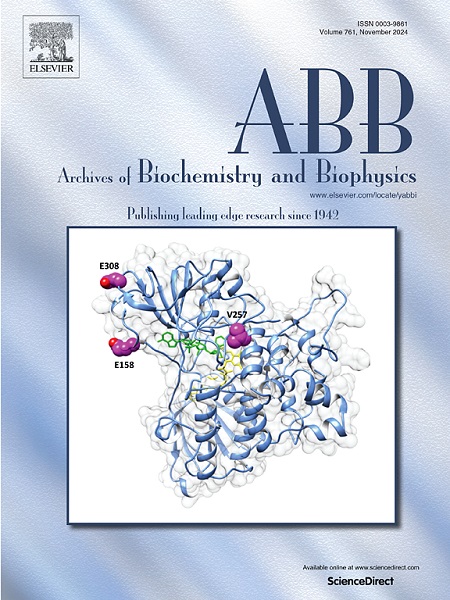Structurally guided engineering of flavin-dependent nicotine dehydrogenase
IF 3.8
3区 生物学
Q2 BIOCHEMISTRY & MOLECULAR BIOLOGY
引用次数: 0
Abstract
Nicotine is a toxic alkaloid found in tobacco leaves that contaminates the environment when the leaves are smoked. In the present study, developed an enzyme technology for nicotine biodegradation and addressed biodetection applications. Recombinant wild-type nicotine oxidase/dehydrogenase from Pseudomonas sp. HZN6 (Nox-WT) was overexpressed and purified to ensure homogeneity. Nox-WT was clearly classified as a flavin adenine dinucleotide (FAD)-containing dehydrogenase, which catalyzes rapid nicotine oxidation in its reductive half-reaction; however, its oxidative half-reaction with O2 was slow and was identified as the rate-limiting step. An imbalance in the rate between the two half-reactions limits the overall catalytic turnover of Nox-WT. According to kinetic behavior, incomplete flavin recovery and substrate inhibition were also identified as obstructed issues that limit the enzyme efficiency. Nox-WT engineering has been performed to address these problems. The modeled structure of Nox-WT was constructed using AlphaFold to design candidate residues for site-directed mutagenesis. Using systematic screening through rapid kinetic techniques, all the limitations were eliminated in the engineered triple mutated Nox-Y338F/H364V/W423H. The mutations at Y338F and H364V expanded the tunnel for O2 accessibility, resulting in 21-fold faster FAD oxidation by O2 in this mutant than in Nox-WT. Mutation at W423H disrupted the binding of nicotine; therefore, substrate inhibition was removed, and FAD was fully recovered. Nox-Y338F/H364V/W423H potentially transforms nicotine considerably faster than Nox-WT without loss of enzyme thermostability. Overall, using a rational design, we successfully engineered an effective mutant of Nox that would be useful for future applications.
黄素依赖性尼古丁脱氢酶的结构导向工程
尼古丁是一种有毒的生物碱,存在于烟叶中,当人们吸食烟叶时,它会污染环境。本研究开发了一种用于尼古丁生物降解的酶技术,并探讨了其在生物检测中的应用。对假单胞菌HZN6 (Nox-WT)重组野生型尼古丁氧化酶/脱氢酶进行过表达和纯化,以确保其均匀性。Nox-WT被明确归类为含黄素腺嘌呤二核苷酸(FAD)脱氢酶,在其还原半反应中催化尼古丁快速氧化;然而,它与O2的半氧化反应缓慢,被确定为限速步骤。两个半反应之间的速率不平衡限制了Nox-WT的整体催化周转。根据动力学行为,黄素恢复不完全和底物抑制也被确定为限制酶效率的障碍问题。已经执行了Nox-WT工程来解决这些问题。利用AlphaFold构建Nox-WT模型结构,设计用于定点诱变的候选残基。通过快速动力学技术的系统筛选,消除了三突变Nox-Y338F/H364V/W423H的所有限制。Y338F和H364V的突变扩大了O2可及性通道,导致该突变体中FAD被O2氧化的速度比ox- wt快21倍。W423H突变破坏了尼古丁的结合;因此,底物抑制被去除,FAD完全恢复。Nox-Y338F/H364V/W423H可能比Nox-WT更快地转化尼古丁,而不会失去酶的热稳定性。总的来说,通过合理的设计,我们成功地设计了一种有效的Nox突变体,这将对未来的应用有用。
本文章由计算机程序翻译,如有差异,请以英文原文为准。
求助全文
约1分钟内获得全文
求助全文
来源期刊

Archives of biochemistry and biophysics
生物-生化与分子生物学
CiteScore
7.40
自引率
0.00%
发文量
245
审稿时长
26 days
期刊介绍:
Archives of Biochemistry and Biophysics publishes quality original articles and reviews in the developing areas of biochemistry and biophysics.
Research Areas Include:
• Enzyme and protein structure, function, regulation. Folding, turnover, and post-translational processing
• Biological oxidations, free radical reactions, redox signaling, oxygenases, P450 reactions
• Signal transduction, receptors, membrane transport, intracellular signals. Cellular and integrated metabolism.
 求助内容:
求助内容: 应助结果提醒方式:
应助结果提醒方式:


